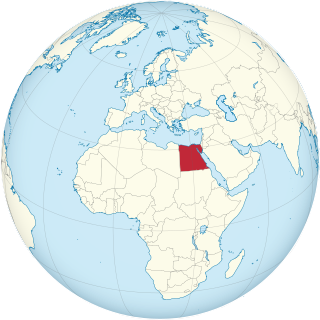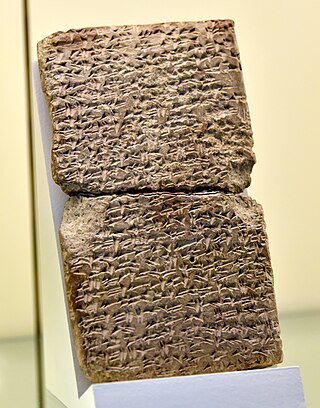
Horus, also known as Hor, in Ancient Egyptian, is one of the most significant ancient Egyptian deities who served many functions, most notably as the god of kingship, healing, protection, the sun, and the sky. He was worshipped from at least the late prehistoric Egypt until the Ptolemaic Kingdom and Roman Egypt. Different forms of Horus are recorded in history, and these are treated as distinct gods by Egyptologists. These various forms may be different manifestations of the same multi-layered deity in which certain attributes or syncretic relationships are emphasized, not necessarily in opposition but complementary to one another, consistent with how the Ancient Egyptians viewed the multiple facets of reality. He was most often depicted as a falcon, most likely a lanner falcon or peregrine falcon, or as a man with a falcon head.

Achshaph was a royal city of the Canaanites, in the north of Canaan. The name means "sorcery".

Articles related to Egypt include:

Menmaatre Seti I was the second pharaoh of the Nineteenth Dynasty of Egypt during the New Kingdom period, ruling c. 1294 or 1290 BC to 1279 BC. He was the son of Ramesses I and Sitre, and the father of Ramesses II.

Migdol, or migdal, is a Hebrew word which means either a tower, an elevated stage, or a raised bed. Physically, it can mean fortified land, i.e. a walled city or castle; or elevated land, as in a raised bed, like a platform, possibly a lookout.

Edfu is an Egyptian city, located on the west bank of the Nile River between Esna and Aswan, with a population of approximately 60,000 people. Edfu is the site of the Ptolemaic Temple of Horus and an ancient settlement, Tell Edfu. About 5 km (3.1 mi) south of Edfu are remains of ancient pyramids.

Labaya was the ruler of Shechem and warlord in the central hill country of southern Canaan during the Amarna Period. He lived contemporaneously with Pharaoh Akhenaten. Labaya is mentioned in several of the Amarna Letters. He is the author of letters EA 252–54.

Abdi-Ḫeba was a local chieftain of Jerusalem during the Amarna period. Egyptian documents have him deny he was a mayor (ḫazānu) and assert he is a soldier (we'w), the implication being he was the son of a local chief sent to Egypt to receive military training there.

Rib-Hadda was king of Byblos during the mid fourteenth century BCE. He is the author of some sixty of the Amarna letters all to Akhenaten. His name is Akkadian in form and may invoke the Northwest Semitic god Hadad, though his letters invoke only Ba'alat Gubla, the "Lady of Byblos".
Articles related to Modern Egypt include:

Ankhtifi was an ancient Egyptian nobleman, administrator, and military commander. The nomarch of Nekhen and a supporter of the pharaoh in Heracleopolis Magna, which was locked in a conflict with the Theban based 11th Dynasty kingdom for control of Egypt. Hence, Ankhtifi was possibly a rival to the Theban rulers Mentuhotep I and Intef I. He lived during the First Intermediate Period, after the Egyptian Old Kingdom state had collapsed, and at a time when economic hardship, political instability, and foreign invasion challenged the fabric of Egyptian society.

The Temple of Edfu is an Egyptian temple located on the west bank of the Nile in Edfu, Upper Egypt. The city was known in the Hellenistic period in Koinē Greek: Ἀπόλλωνος πόλις and in Latin as Apollonopolis Magna, after the chief god Horus, who was identified as Apollo under the interpretatio graeca. It is one of the best preserved shrines in Egypt. The temple was built in the Ptolemaic Kingdom between 237 and 57 BC. The inscriptions on its walls provide important information on language, myth and religion during the Hellenistic period in Egypt. In particular, the Temple's inscribed building texts "provide details [both] of its construction, and also preserve information about the mythical interpretation of this and all other temples as the Island of Creation." There are also "important scenes and inscriptions of the Sacred Drama which related the age-old conflict between Horus and Seth." They are translated by the Edfu-Project.
NIN-UR.MAH.MEŠ, or the "Lady" of the Lions, was the author of two letters to the pharaoh, the King of Ancient Egypt, in the 1350–1335 BC Amarna letters correspondence. Her name is a representation of the original written script characters of Babylonian 'Sumerograms' , "NIN- + UR.MAH + (plural:MEŠ)", and means, "woman–lion–plural", namely: "Lady Lions".. The Amarna letters are mostly written in Akkadian cuneiform, with local words/phrases/etc due to various city-states or countries.

Ayyab was a ruler of Aštartu south of Damascus. According to the Amarna letters, cities/city-states and their kings in the region — just like countries to the north, such as Hatti of the Hittites, fell prey to a wave of attacks by ʿApiru raiders. The Amarna correspondence corpus covers a period from 1350–1335 BC.
Biridašwa was a mayor of Aštartu, (Tell-Ashtara), south of Damascus,, during the time of the Amarna letters correspondence, about 1350–1335 BC. A second mayor of Aštartu, Ayyab, existed in this short 15–20 year time period.

Tunip was a city-state along the Orontes River in western Syria in the Late Bronze Age. It was large enough to be an urban center, but too small to be a dominant regional power. It was under the influence of various factions like the Mitanni, Egyptians, and Hittites.
Šuta, ("Shuta"), was an Egyptian commissioner of the 1350–1335 BC Amarna letters correspondence. The name Šuta is a hypocoristicon-(nickname/petname) for the Ancient Egyptian god Seth,.

Nehesy Aasehre (Nehesi) was a ruler of Lower Egypt during the fragmented Second Intermediate Period. He is placed by most scholars into the early 14th Dynasty, as either the second or the sixth pharaoh of this dynasty. As such he is considered to have reigned for a short time c. 1705 BC and would have ruled from Avaris over the eastern Nile Delta. Recent evidence makes it possible that a second person with this name, a son of a Hyksos king, lived at a slightly later time during the late 15th Dynasty c. 1580 BC. It is possible that most of the artefacts attributed to the king Nehesy mentioned in the Turin canon, in fact belong to this Hyksos prince.
This page list topics related to ancient Egypt.












